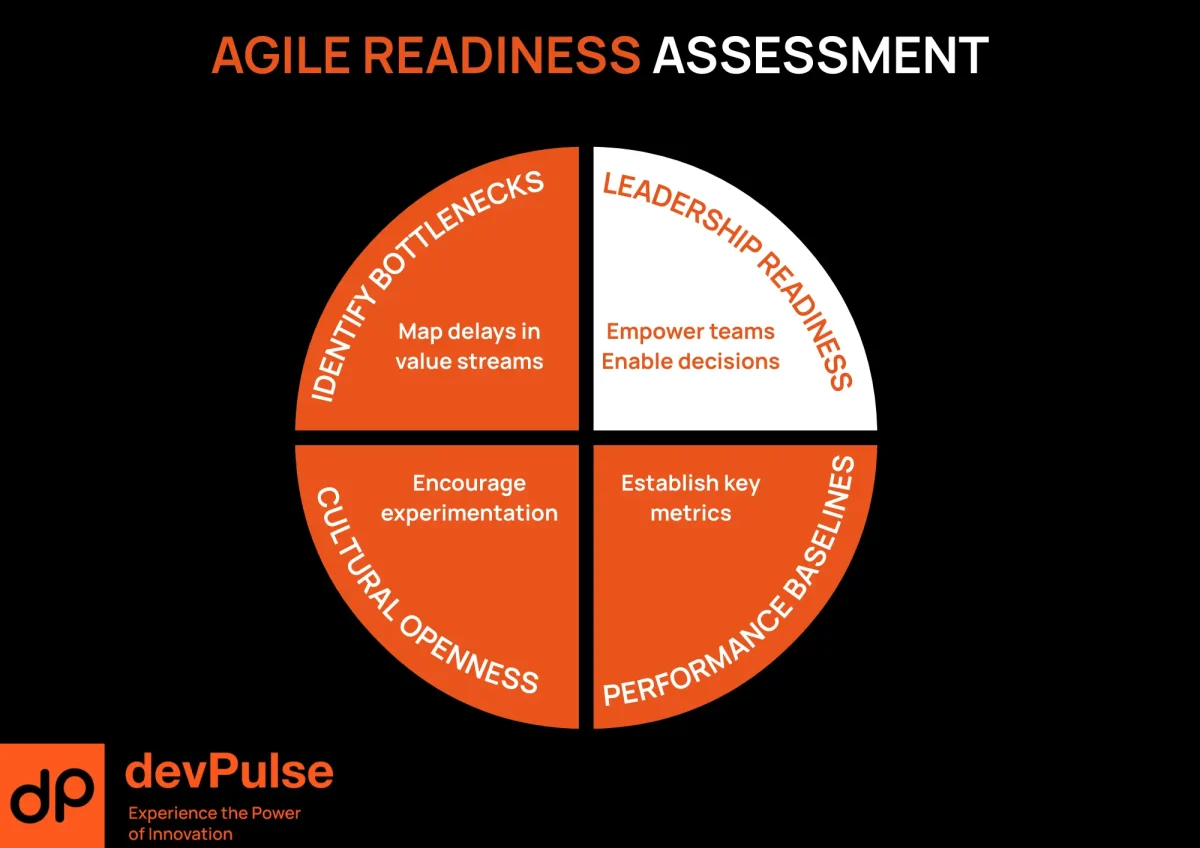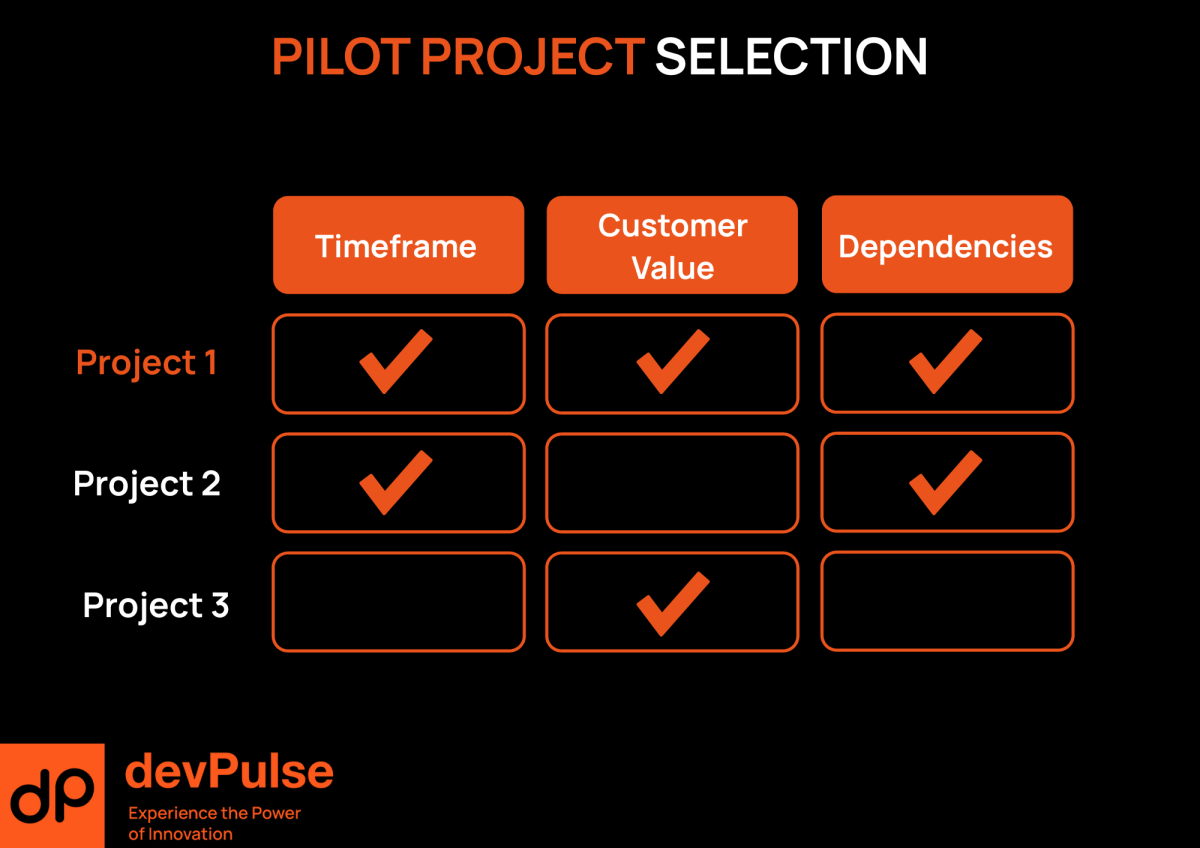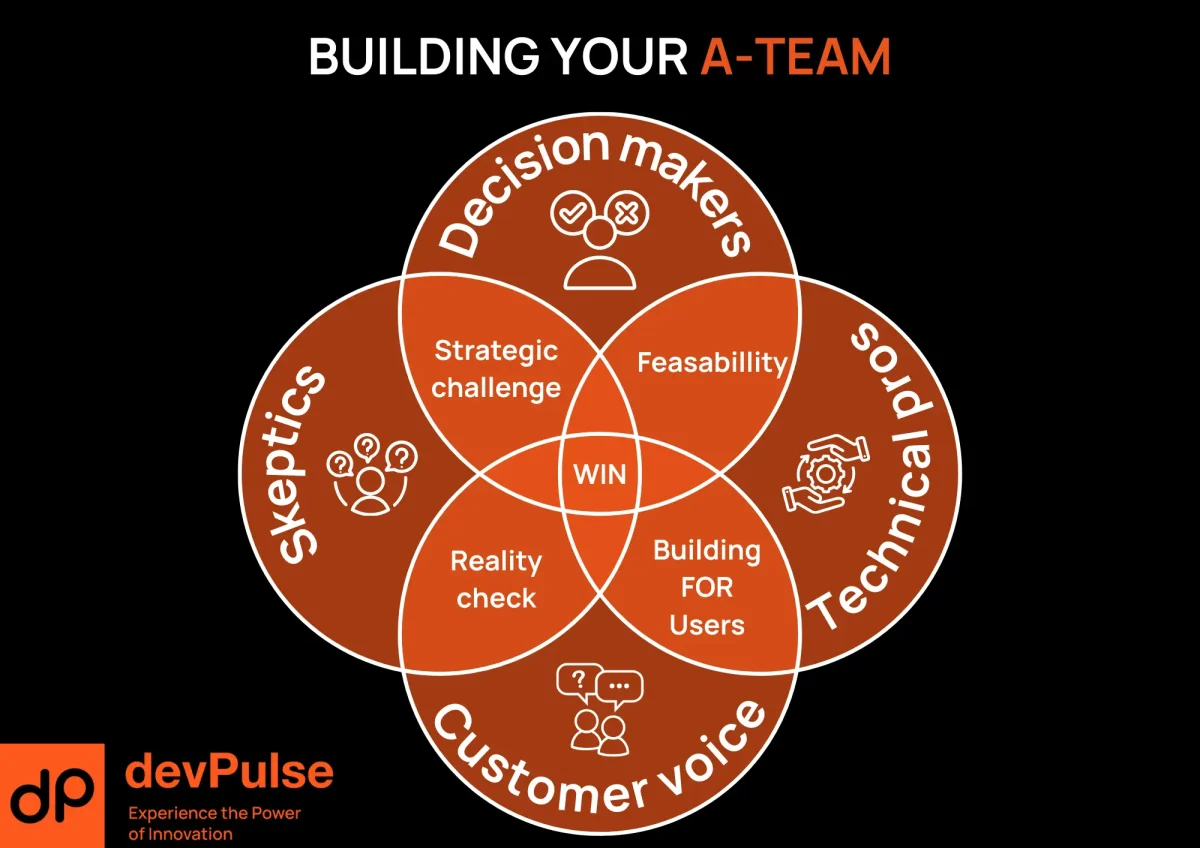Updated April, 2025
Organizations across every sector are under pressure to adapt quickly to shifting markets and evolving customer needs. Organizations across every sector are under pressure to adapt quickly to shifting markets and evolving customer needs. Yet for many, true agility remains elusive. Leaders announce a bold new way of working, but deep-rooted silos, legacy mindsets, and outdated processes often derail early enthusiasm. How do you start an agile transformation that genuinely sticks-and delivers measurable value?
Drawing on findings from the 15th State of Agile Report and insights from McKinsey’s research on creating agile organizations, this roadmap provides a pragmatic approach to breaking down barriers, forming cross-functional teams, and accelerating innovation. It also integrates key takeaways from our internal Digital Transformation in 2025 guide and references to complementary devPulse resources-helping you see how agile transformation ties into broader modernization efforts.
Below, you’ll find a streamlined path to assessing readiness, picking your pilot project, and scaling agility sustainably. Each step emphasizes both structural changes and cultural shifts, ensuring you address the root issues that hamper true innovation.
1. Clarify Your Organization’s Agile Readiness
Moving to an agile model starts by taking an honest look at where you stand. According to PMI’s Pulse of the Profession research, organizations that conduct a candid readiness assessment are significantly more likely to see long-term success.
- Identify your biggest workflow bottlenecks. Many teams can’t pinpoint the top delays that stall their projects, making it tough to know where agile can help. A quick way to start is by mapping one value stream from request to delivery-note each handoff or waiting period to reveal hidden waste.
- Realign leadership expectations. Agile demands a shift from top-down approval to enablement-focused leadership. This means managers must trust teams, empower faster decision-making, and eliminate bureaucratic approvals.
- Assess cultural attitudes toward experimentation. Sustainable agility hinges on openness to new ideas and tolerance for “fast failure.” If your culture punishes mistakes, teams will avoid the very experiments that fuel continuous improvement.
- Establish performance baselines. Metrics like cycle time, defects, and customer satisfaction become your reference points. As a Gartner summary of the 2025 CIO Agenda suggests, data-driven metrics demonstrate improvement and help sustain executive buy-in.
Watch For…
- Managers who cling to approval-based control
- Teams at 100% utilization with no capacity to learn new ways
- Frequent blame and fear of failure
- Multiple approval layers before decisions
- A history of uncompleted change initiatives
Organizations exhibiting several of these patterns can still transform, but it’s crucial to resolve fundamental leadership and cultural gaps before sprinting into new processes.

Related Reading:
- Digital Transformation Solutions – Explore how agile fits into broader digital transformation strategies.
- Legacy System Modernization Guide – See how readiness factors also apply when modernizing outdated tech stacks.
2. Select a Strategic Pilot Project
Your first agile initiative should serve two purposes: build early momentum and prove agile’s business value. In the Scrum Alliance’s State of Scrum reports, successful transformations typically start with a project that’s feasible yet visible enough to inspire interest.
Look for a pilot that meets these criteria:
- Visible Across the Organization
Pick something that will be noticed—not necessarily your highest-stakes initiative, but a project that touches enough stakeholders to showcase real outcomes. - Completes in 6–8 Weeks
Short feedback loops are key. Three agile sprints (2-week cycles) usually provide enough time to deliver tangible results without dragging on for months. - Directly Tied to Customer Value
Teams feel more motivated—and executives pay closer attention—when the pilot clearly impacts end users or external customers. - Minimizes External Dependencies
Seek a project where your newly formed agile team can control most inputs. Fewer handoffs reduce risk, especially when people are new to agile methods.

Example:
A financial services firm improved its customer onboarding flow rather than overhauling its entire transaction engine. This smaller project ran only two months yet proved the value of faster iterations. Soon after, leadership green-lit agile practices for larger initiatives.
Common Pitfalls:
- Starting too big (e.g., an all-encompassing, multi-department program)
- Picking a “pet project” with uncertain business value
- Failing to involve the actual delivery team in pilot selection
Related Reading:
- Cloud Migration Strategy – For pilot ideas around shifting a single legacy app to the cloud.
- Product Enhancement Services – Explore how to deliver quick wins on smaller product features to showcase agile.
3. Build Your Cross-Functional “A-Team”
Agile thrives on autonomy, collaboration, and diverse expertise. Simply labeling a group “agile” won’t deliver results if old silos remain. KPMG’s Agile Transformation Case Studies highlight the importance of forming genuine cross-functional squads with the authority to solve problems end to end.
Include four critical perspectives:
- Decision Makers – Individuals with authority to remove roadblocks or approve resources instantly.
- Skeptics – Voices who question assumptions and expose risks. When convinced, they become vocal advocates.
- Technical Specialists – Developers, architects, or engineers who understand system constraints and design sustainable solutions.
- Customer Voice – Actual users or representatives who ensure features align with real needs, not guesswork.
Team Size & Time Allocation:
- Aim for 5-9 members. Larger teams often splinter communication.
- Provide at least 20% “protected time” for pilot work. Expecting 100% of normal duties plus a brand-new agile project leads to burnout and half-hearted adoption.

Note: As Standish Group CHAOS Report data suggests, frequent communication and well-defined roles often matter more than rigid frameworks. When your A-Team can make real-time decisions and see direct customer impact, they are more likely to stay motivated and productive.
Related Reading:
- Tech Consulting Services – Learn how external expertise can supplement your pilot’s skill gaps.
- Modern Tech Stack Guide 2025 – See how the right technical foundation supports cross-functional agility.
4. Establish a Solid Knowledge Foundation
Even the most promising pilot will stall if teams lack a baseline understanding of agile practices. According to Harvard Business Review’s Agile at Scale, organizations that invest in foundational learning (like visualizing work, holding short daily syncs, and practicing continuous feedback) see better outcomes than those that leap straight to advanced tools.
Avoid the “Tools Trap”
Enterprises often rush to buy expensive agile platforms. Although tools like Jira or Azure DevOps can help, start with simple boards (physical or virtual) to visualize tasks and limit work in progress. The 15th State of Agile Report notes that 76% of top performers began with basic boards and daily standups before adopting more advanced software.
Create a Team Space
Whether physical or digital, a dedicated collaboration environment fuels transparency. Keep the backlog, metrics, and current tasks in plain sight so everyone can identify blockers without guesswork.
Conversations Trump Documentation
While documents matter, agility depends heavily on face-to-face (or video) interactions for clarifying requirements and resolving ambiguities. Scrum Alliance research shows that teams who consistently rely on direct communication resolve issues faster and produce fewer misunderstandings.
Learn by Doing
Short training sessions are helpful, but real mastery comes from hands-on practice with sprint planning, standups, and retrospectives. As you refine the basics, you can explore advanced topics like DevOps pipelines or scaled frameworks.
5. Execute a Structured First Month
The initial 30 days set the tone for everything that follows. This period should lock in agile habits, demonstrate quick wins, and generate excitement across the company. According to IBM’s own Agile Journey, focusing on small, early victories can shift hesitant stakeholders into champions.
- Observe (Week 1)
- Map your current workflow. Identify cycle times and hidden delays.
- Launch daily standups-keep them under 15 minutes.
- Invite leadership to attend the pilot kickoff.
- Form (Weeks 1-2)
- Finalize your cross-functional A-Team roles.
- Establish working agreements (e.g., how decisions get made, how often to demo progress).
- Provide a short, hands-on training session so everyone grasps the basics of sprints, user stories, and retros.
- Train (Ongoing)
- Offer just-in-time learning experiences. For instance, conduct a backlog-refinement workshop right before the first sprint planning.
- Keep sessions short (under 90 minutes) so teams can immediately apply new skills.
- Launch (Weeks 2-4)
- Start your first sprint with a well-defined scope.
- Run daily standups focused on flow (not status updates).
- End each sprint with a demo and a retrospective. Use that retrospective to implement at least one improvement before the next sprint.
Success Factor: Communicate progress and challenges openly-brief weekly updates to broader stakeholders can dispel doubts and showcase the pilot’s achievements.
Related Reading:
- Digital Process Automation – Learn how to automate routine workflows during your first sprints.
- Custom Software Development – Explore agile practices for faster, iterative software delivery.
6. Anticipate Real-World Challenges
Even the most systematic rollout encounters hurdles-especially when middle management feels threatened or when legacy norms clash with new ways of working. A McKinsey report on “How to tame the transformation” notes that preparing teams for these realities early on improves long-term success.
Middle Management Resistance
Some mid-level leaders may see agile as undermining their authority. To address this, redefine manager roles as team enablers who clear roadblocks and coach self-organizing teams. Highlight new career paths like Scrum Master or Product Owner to show that leadership skills remain critical.
Siloed Departments
Rigid structures slow down cross-functional collaboration. Encouraging “team-of-teams” coordination-where multiple squads share knowledge-reduces bottlenecks. Co-locate or create strong virtual channels so different functions can solve issues in real-time rather than passing tasks through email.
Misaligned Incentives
If your performance reviews still reward only individual output, collaboration will suffer. Instead, incorporate team-based achievements into recognition systems. According to the Harvard Business Review article “Agile at Scale,” adjusting incentives toward collective goals speeds adoption dramatically.
Transparency Discomfort
Agile methods surface hidden flaws fast, which can feel uncomfortable. Reinforce a “no blame” environment. Praise teams for spotting problems early rather than punishing them for imperfections.
Legacy Technology Constraints
For transformations touching old systems, agile teams often face technical debt. A parallel track for incremental modernization can mitigate bottlenecks. Consider referencing our Legacy System Modernization Guide to learn how agile sprints can systematically retire or refactor legacy code.
7. Measure What Matters
A transformation without metrics is just guesswork. Digital.ai’s 15th State of Agile Report reveals that agile adoptions with clear KPIs are twice as likely to sustain beyond the pilot phase. Use both business metrics and cultural indicators to track progress:
Key Business Metrics
- Time to Market
Measure how quickly an idea moves from concept to delivery. Shortening this cycle shows agility’s direct impact on revenue or user satisfaction. - Customer Satisfaction
Tools like NPS (Net Promoter Score) or CSAT reveal whether faster iteration genuinely improves customer outcomes. - Defect Rates / Quality Indicators
Track escaped defects, rework, and mean time to restore service. Agile typically reduces rework by catching issues earlier. - Release Frequency & Predictability
How often do you deploy working software? Does each sprint deliver on its commitments?
Cultural Indicators
- Employee Engagement
Survey teams on role clarity, autonomy, and collaboration. People-centric metrics highlight whether agile truly shifts mindsets. - Cross-Team Collaboration
Note how often squads share resources or jointly tackle bottlenecks. Fewer silos mean broader knowledge flow. - Retrospective-Driven Improvements
Are teams identifying tangible improvements every sprint-and actually implementing them? - Decision-Making Speed
Track how many decisions can be made at the team level versus escalated. Decreasing approval layers signals genuine empowerment.
Use a simple dashboard to publicize metrics weekly or bi-weekly. McKinsey points out that transformations with transparent progress reports keep leaders invested and teams motivated.
8. Scale Thoughtfully Beyond the Pilot
Once you’ve proven success with your pilot teams, you can expand agile methods across the organization. The Spotify Engineering Culture case shows that scaling is most effective when teams maintain a high degree of autonomy and knowledge-sharing.
Three Approaches to Scaling
- Organic Spread
Let successful practices naturally spread through internal advocates. Pro: builds strong cultural acceptance. Con: can be slow and uneven. - Programmatic Frameworks
Implement a structured approach like SAFe (Scaled Agile Framework) or LeSS. Pro: consistent practices across teams. Con: risk of bureaucracy if applied rigidly. - Hybrid (Recommended)
Blend organic adoption with a guiding structure. Provide a center of excellence for coaching, but allow teams to adapt agile practices to local contexts.
Sustain Culture During Growth
- Share success stories from pilot teams.
- Rotate staff across squads to disseminate expertise.
- Encourage communities of practice where agile practitioners solve cross-team problems.
- Keep investing in training, especially for new hires.
Conclusion & Next Steps
An agile transformation roadmap isn’t just a process shift-it’s a strategic reimagining of how your company delivers value. By assessing readiness, selecting a focused pilot, building cross-functional teams, establishing foundational practices, and scaling once you prove success, you create an environment where innovation thrives and silos fall away.
Actionable Next Steps:
- Pinpoint specific cultural or leadership obstacles from your readiness assessment and address them early.
- Launch a pilot with clear boundaries, short timelines, and real customer impact.
- Track metrics that link agile improvements to tangible outcomes like time to market or customer satisfaction.
- Communicate wins weekly-especially to stakeholders who might be skeptical.
- Plan how you’ll scale beyond the pilot once momentum builds.
If you’re looking for expert guidance, explore our Tech Consulting Services or learn about our Digital Transformation Solutions for a more customized approach. We’ve helped organizations from finance to health
FAQ: Agile Transformation
Begin by assessing your readiness—pinpoint workflow bottlenecks, gauge leadership’s willingness to delegate, and check cultural openness to experimentation. Pick a small, high-visibility pilot that teams can complete in 6–8 weeks, then track metrics (like cycle time and defect rates) to validate early wins. Once the pilot demonstrates value, expand organically or through a formal scaling framework.
Yes. Digital transformation focuses on adopting modern technologies, rethinking processes, and leveraging data to gain a competitive edge. Agile transformation centers on changing how teams operate—emphasizing iterative delivery, fast feedback, and cross-functional collaboration. Often, agile enables digital transformation by speeding up technology initiatives and ensuring teams can adapt rapidly.
It varies, but common returns include faster time to market, reduced rework, improved team engagement, and higher customer satisfaction. Some organizations see a significant uptick in revenue or cost savings if they measure carefully (e.g., by comparing pre- and post-transformation metrics). According to the Standish Group CHAOS Report, improved project success rates often translate directly into lower overhead and better profitability.
You can absolutely start with existing tools—simple boards, chat platforms, and shared docs. It’s more important to learn agile principles (daily standups, sprints, retrospectives) than to buy specialized software immediately. Once you’ve built effective habits, you can decide whether advanced platforms like Jira, Azure DevOps, or other DevOps pipelines will enhance productivity.





